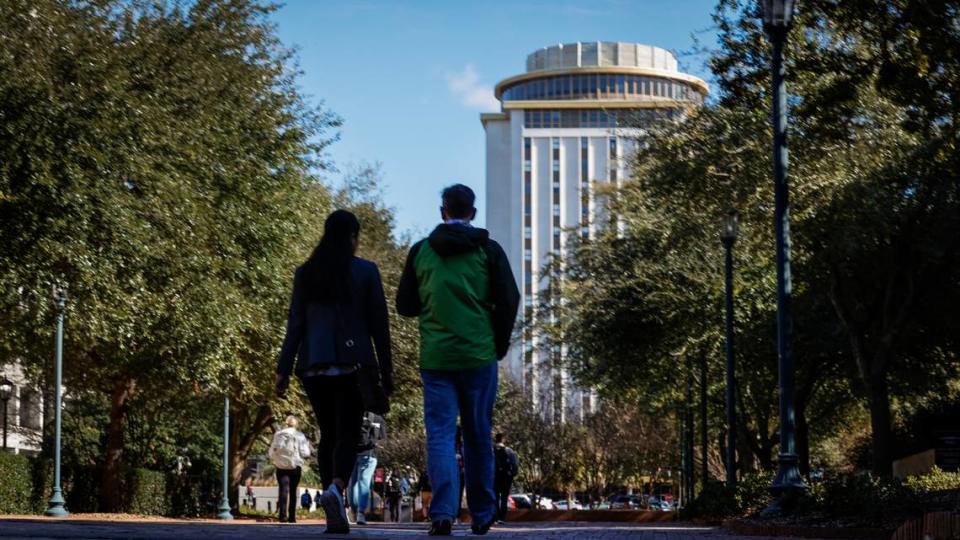SC’s McMaster disagrees with colleges, universities on price tag to freeze tuition again
- Oops!Something went wrong.Please try again later.
South Carolina Gov. Henry McMaster doesn’t want to give colleges and universities as much money as they say they need to freeze tuition rates for a fifth year in a row.
McMaster in his $11.6 billion budget proposal, which was unveiled Friday ahead of the start of this year’s legislative session on Tuesday, only calls for $49.8 million in new annual money to keep tuition rates the same.
The governor’s office based the recommendation on the Higher Education Public Index of 4.5%.
This would be the fifth consecutive year the governor has called for the tuition freeze.
However, state colleges and universities asked for $128 million to pay for tuition mitigation, increased scholarships and increase cost of operation.
The governor’s office said the universities don’t use any indexes to determine their tuition mitigation needs and requests have been twice as much as the higher education index.
Ultimately, it will be a decision for the general assembly as they put together a spending plan for the upcoming fiscal year which begins July 1.
But the governor wants an overall study of the state’s higher education system.
With a decreasing birthrate, a limited number of students in the state, the overall percentage of students going to college dropping and the percentage of students going out of state starting to increase, the governor’s office is questioning whether the state needs 33 institutions of higher education and where they should be located.
McMaster wants to spend $3 million on an outside study, overseen by the Education Oversight Committee, a nonpartisan panel with nothing to gain or lose in the process.
The study would look at how well space is used at colleges and universities, whether certain technical colleges and universities be consolidated and where is the best locations for schools and programs in a state with a growing population.
“This study will address the sustainability, accessibility and affordability, as well as provide an assessment of the need for consolidation of existing physical space, programs, certificates and degrees offered at our public colleges and universities as compared to the projected workforce needs of our state in the future,” McMaster wrote in a letter presenting his executive budget.
While speaking to reporters Friday, McMaster said conversations on how to best structure the universities in the state have been ongoing.
“We want to be sure that we are providing the right instruction to our students and we’re not overlapping, we’re not wasting time or money,” McMaster said. “Some of our schools are not getting as many students as they would like and we just want to do the best we can.”
The state’s research, four-year and two year colleges are sitting on $1.5 billion worth of unrestricted money, which ranges from 9.4% to 63% of an institution’s annual operating budget. The technical colleges have $166 million of unrestricted money in the bank, which ranges from -2.4% to 72% of technical colleges’ operating budgets.
Schools have high cash balances because in recent years they didn’t spend money during the pandemic with students not on campus, unspent federal COVID money, and the general assembly has been “very generous” to higher education, the governor’s office said.
McMaster also only wants to spend $44 million on deferred maintenance at colleges and universities, even though they’ve made $1.7 billion in capital expenses
Even though the University of South Carolina is seeing a record number of applications, the other schools around the state are seeing a decline in students.
Students that normally attend USC-Aiken, USC-Upstate, USC-Beaufort or Francis Marion, are now attending the University of South Carolina’s Columbia campus or Clemson, the governor’s office said.
In addition, as part of a plan to make sure college is affordable, McMaster proposed spending $100 million more in needs based financial aid and $95 million for workforce development scholarships.
The state also has an additional $152 million in one-time unspent lottery money for scholarships. McMaster proposed spending $70 million for additional needs based grants and money to help students enroll for one more semester to complete a degree traditionally done in four years.
He also wants to use $30 million in unspent lottery scholarship money on training for high demands jobs at technical colleges.


